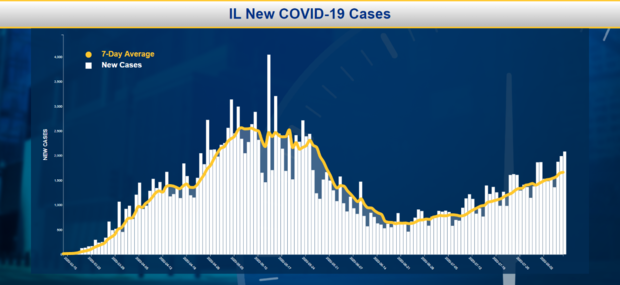Coronavirus In Illinois: New COVID-19 Cases Top 2,000 For First Time Since Late May
CHICAGO (CBS) -- Illinois surpassed more than 2,000 new cases of COVID-19 on Friday, the first time the state has reached that mark in more than two months, as the state's positive test rate continues to inch upward.
The Illinois Department of Public Health on Friday announced 2,084 new confirmed cases of the novel coronavirus, including 21 additional deaths. The last time the state reported more than 2,000 new cases was May 24, when IDPH reported 2,508 infections.
The state's daily case counts have been rising steadily since late June, though not as quickly as the original surge of cases in April and May.
The new cases announced Friday came as IDPH reported 46,869 virus tests in the past 24 hours, for a one-day positive test rate of 4.4%. The seven-day statewide positive test rate for the past week is up to 4.1%, compared to 3.4% two weeks ago, and 2.5% in early July.
As of Thursday night, 1,486 coronavirus patients were being treated in Illinois hospitals, including 333 in intensive care, and 125 on ventilators.
So far, the vast majority of COVID-19 patients have recovered from the disease, with a 95% statewide recovery rate as of Thursday. The state's recovery rate calculates the number of people who have tested positive for the virus, and have survived at least 42 days after their test.
Two additional Illinois counties on Friday were placed on "warning level" for COVID-19, meaning tighter restrictions could be imposed if infection rates and hospitalizations in those counties continue to increase. A total of 13 counties are now at warning levels:
Thirteen counties in Illinois -- Cass, Coles, Grundy, Iroquois, Jackson, Monroe, Perry, Saline, St. Clair, Tazewell, Union, Williamson, Winnebago -- have been placed on a "warning level" for COVID-19, meaning they have met the thresholds for two or more "risk factors" for the increase of cases in their area.
According to the Illinois Department of Public Health, those counties have seen outbreaks linked to businesses, long-term care facilities, large social gatherings, and out of state travel. Outbreaks also have been linked to students returning to colleges and universities in some communities, and not wearing masks or social distancing, and gathering in large groups at bars.
IDPH uses several factors to determine if there are warning signs of increased COVID-19 risk in a given county:
- New cases per 100,000 people. If there are more than 50 new cases per 100,000 people in the county, this triggers a warning.
- Number of deaths. This metric indicates a warning when the weekly number of deaths increases more than 20% for two consecutive weeks.
- Weekly test positivity. This metric indicates a warning when the 7-day test positivity rate rises above 8%.
- ICU availability. If there are fewer than 20% of intensive care units available in the region, this triggers a warning.
- Weekly emergency department visits. This metric indicates a warning when the weekly percent of COVID-19-like-illness emergency department visits increase by more than 20% for two consecutive weeks.
- Weekly hospital admissions. A warning is triggered when the weekly number of hospital admissions for COVID-19-like-illness increases by more than 20% for two consecutive weeks.
- Tests perform. This metric is used to provide context and indicate if more testing is needed in the county.
- Clusters. This metric looks at the percent of COVID-19 cases associated with clusters or outbreaks and is used to understand large increase in cases.







